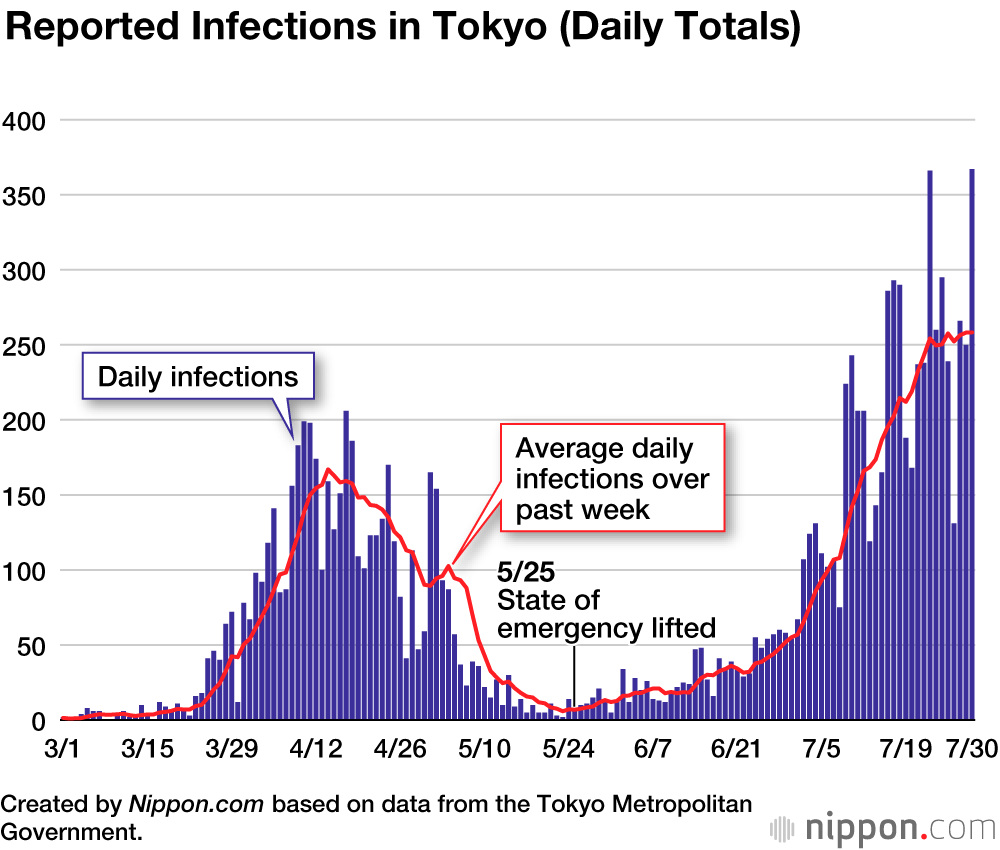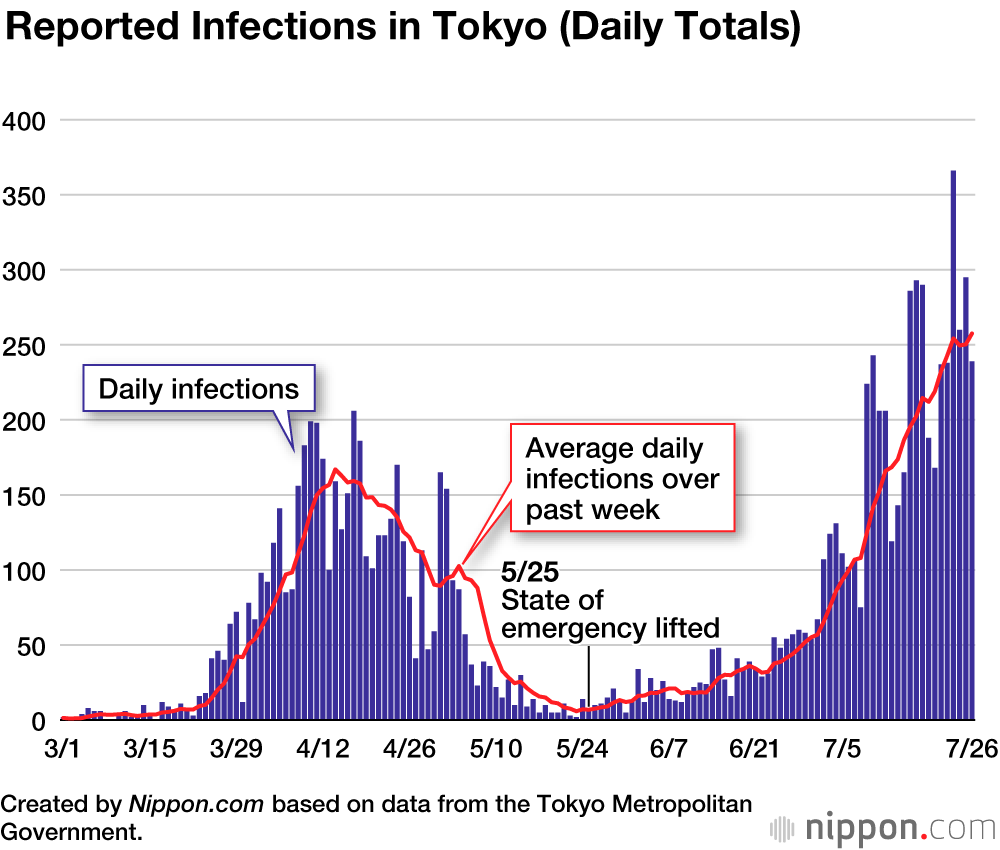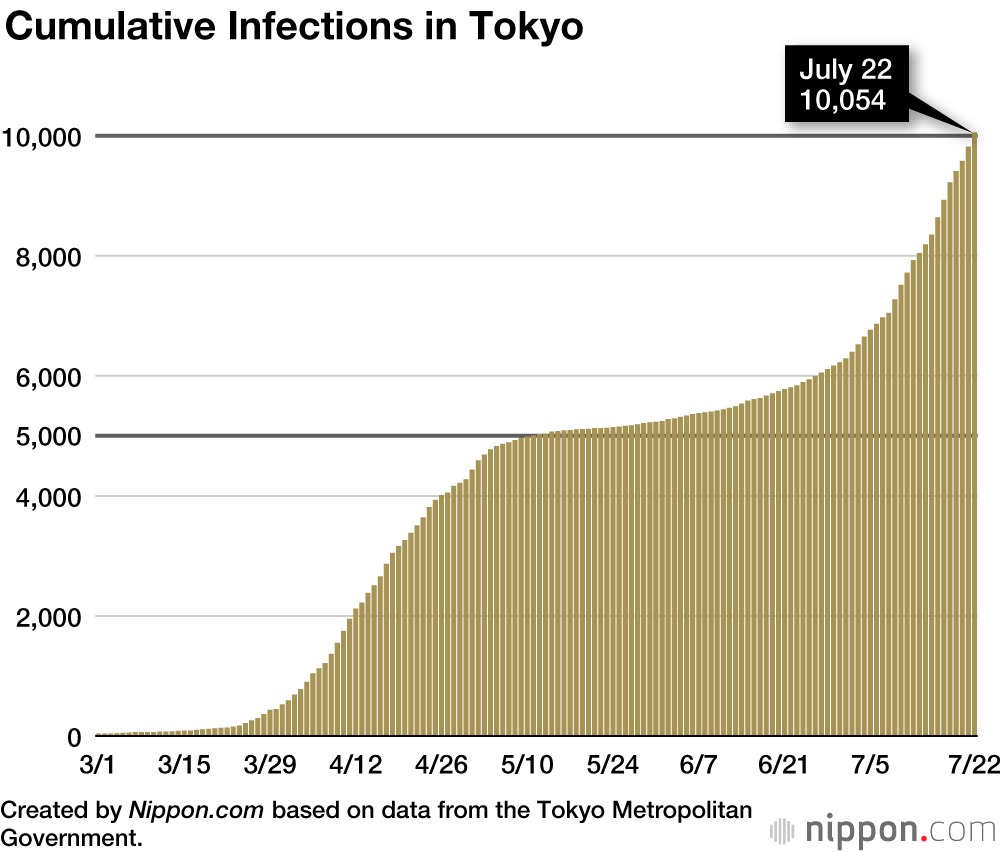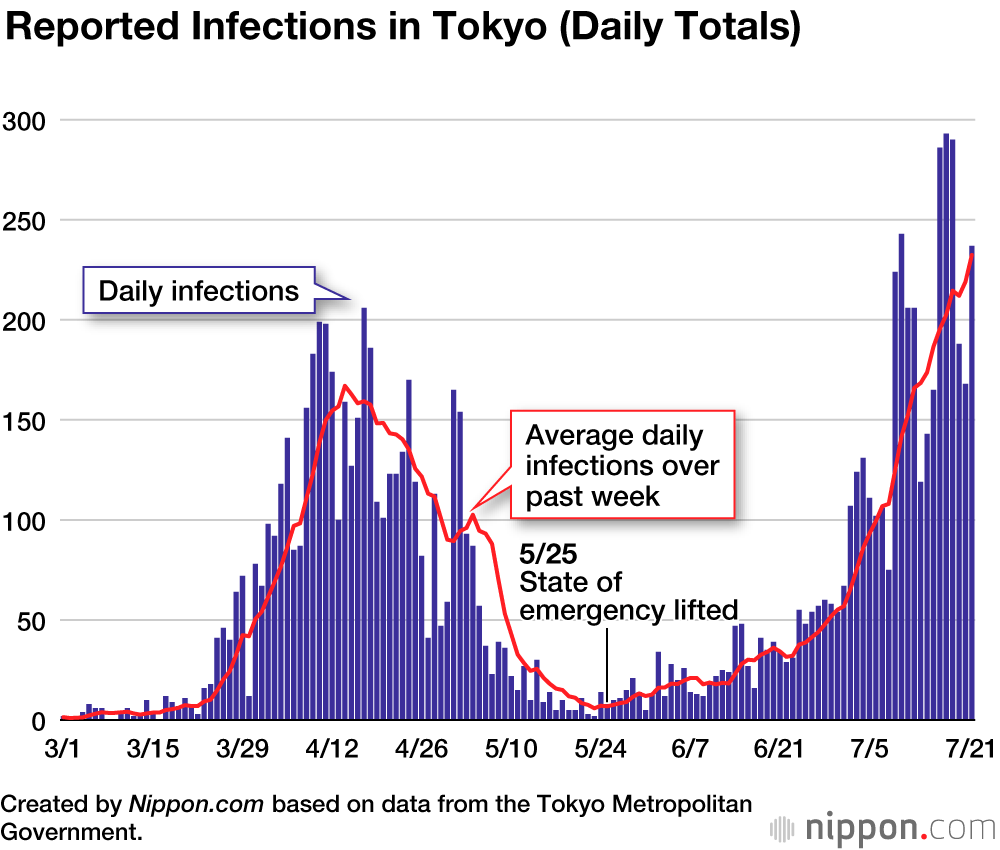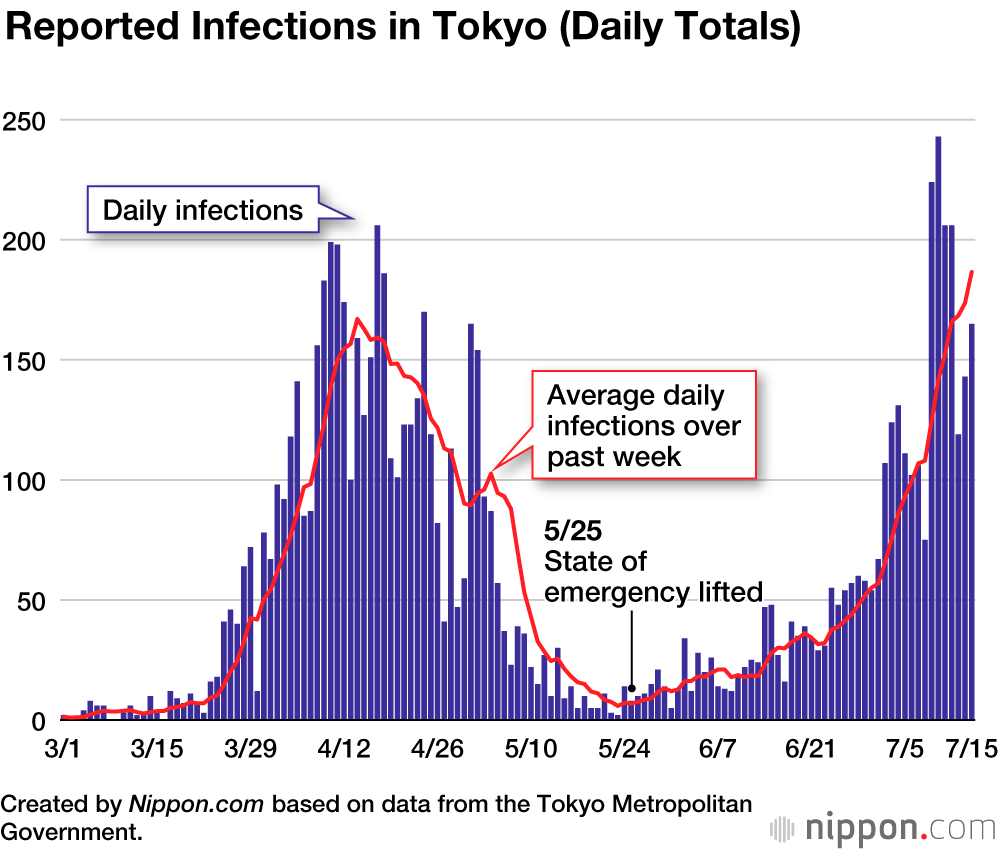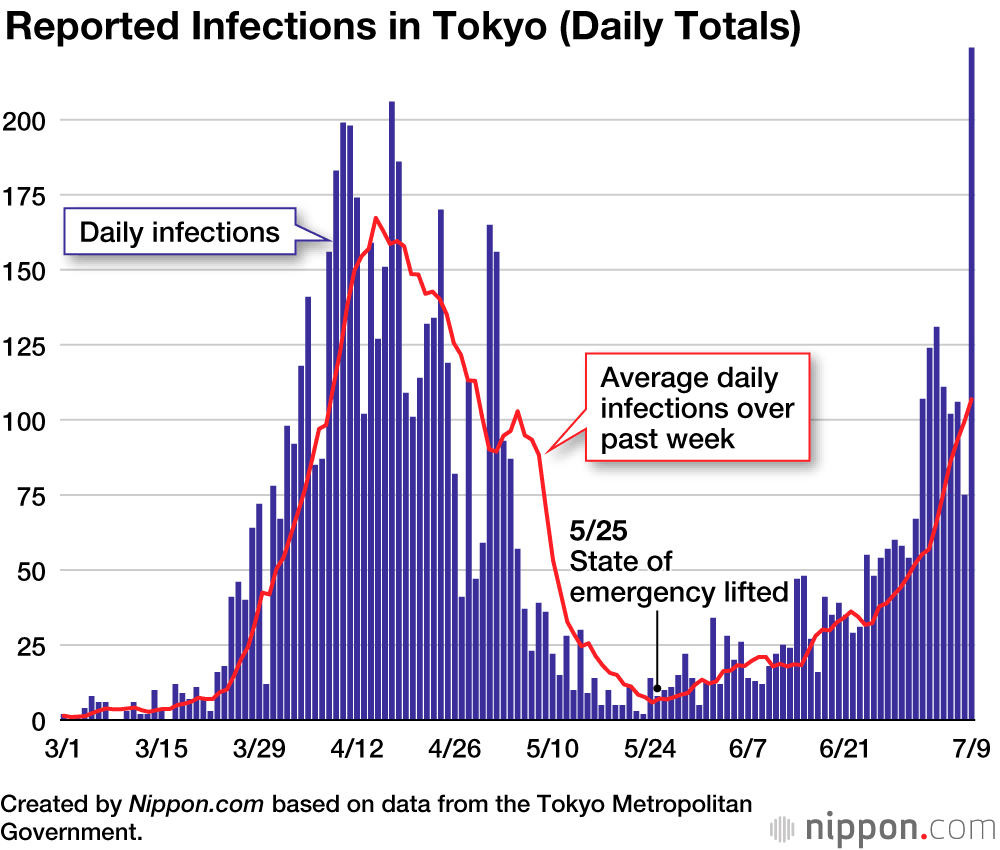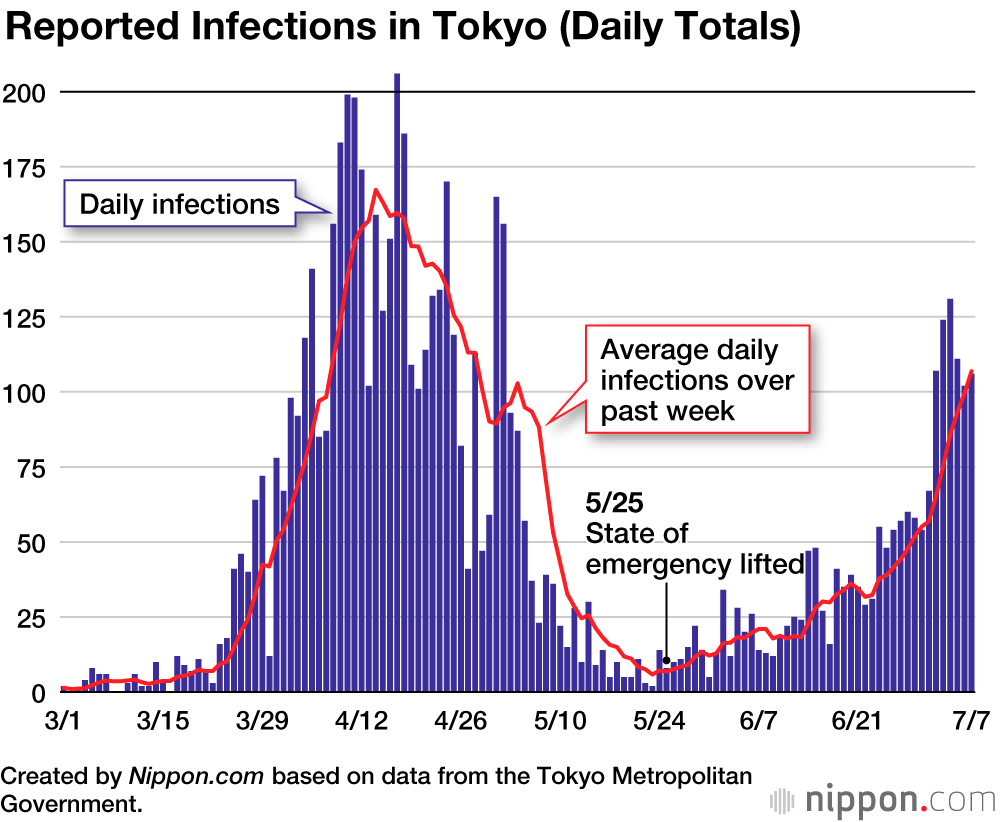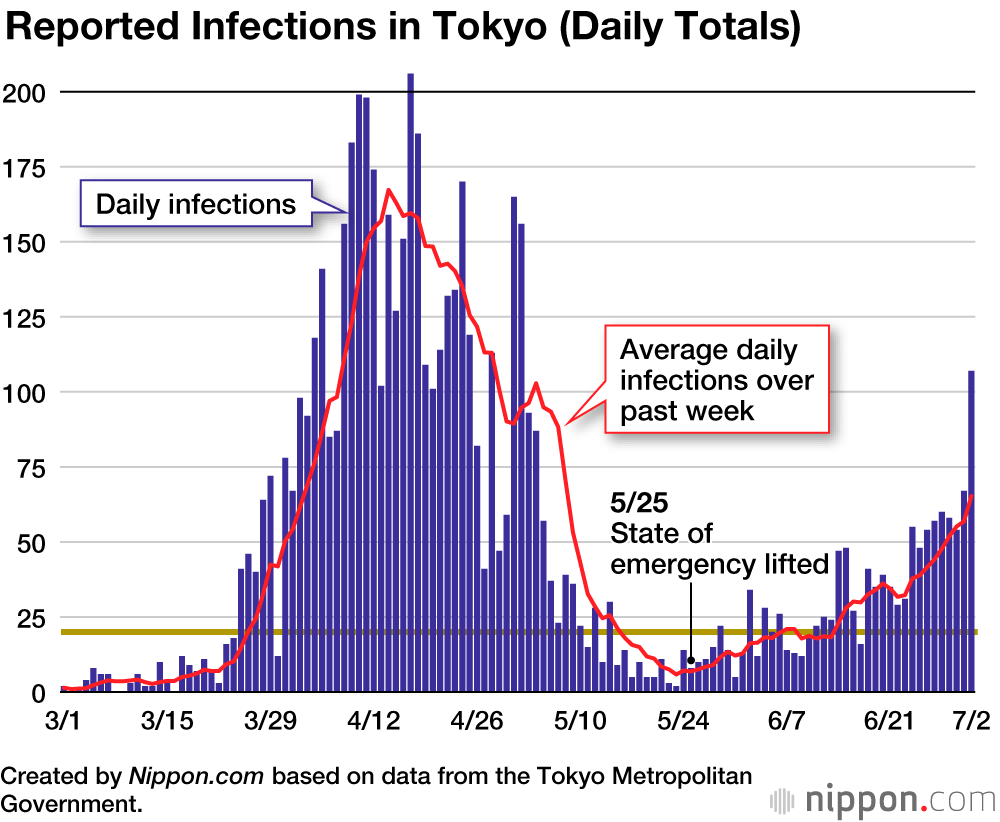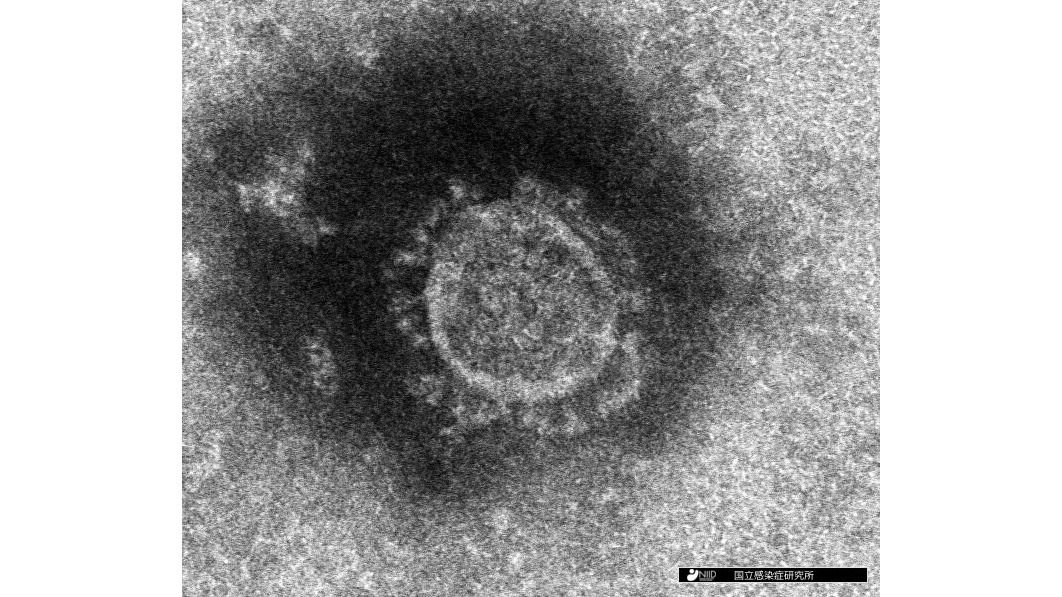
Coronavirus Cases in Japan by Prefecture (July 2020)
Society- English
- 日本語
- 简体字
- 繁體字
- Français
- Español
- العربية
- Русский
Click here for the latest updates.
Click here for updates from August and September.
July 31
The nationwide daily total sets a new record of 1,570. Tokyo reports 463 new cases, topping 400 for the first time and setting a record for the daily total, while Osaka reports 216, Aichi 193, and Fukuoka 170.
The Osaka prefectural government issues business suspension requests to establishments with settai services and karaoke parlors not displaying stickers to show they have introduced measures to prevent infection in the Minami district of the city of Osaka. The requests will last from August 6 to 20. It also asks other such establishments that do display stickers, as well as ordinary bars and restaurants in the district, to shorten operating hours and close at 8:00 in the evening.
July 30
The nationwide daily total sets a new record of 1,305, including Tokyo’s highest total to date of 367 new cases. Governor Koike says that the metropolis may have to declare its own state of emergency and calls on karaoke parlors and establishments serving alochol to close by 10:00 at night from August 3 to 31.
July 29
The nationwide daily total of 1,260 new cases rises above 1,000 for the first time, including 250 in Tokyo, 221 in Osaka, 167 in Aichi, 101 in Fukuoka, and 70 in Kanagawa. The first two cases are also reported in Iwate, which had been the last prefecture yet to report any infections.
July 28
Tokyo reports 266 new cases, bringing its overall total to 11,611. Several prefectures report record highs, including Osaka (155), Aichi (109), Kyoto (31), Gifu (25), and Okinawa (21), contributing to a nationwide total of 981, which equals the record set on July 23.
July 27
Tokyo reports 131 new cases, bringing its overall total to 11,345. This is the first time for the daily figure to drop below 200 in a week, but it was affected by reduced testing. The metropolis has reported over 5,000 new cases since the start of July.
July 26
Tokyo reports 239 new cases for a sixth successive daily figure over 200, bringing its overall total to 11,214. Osaka reports 141, Fukuoka 90, and Aichi 80, contributing to a nationwide total of 828. Including cases confirmed in airport screening, this brings Japan’s total to more than 30,000, a number that will be reflected in the official figures announced as of noon on July 27. It is less than three weeks since the national total rose above 20,000 on July 7.
July 25
Tokyo reports 295 new cases for a fifth successive daily figure over 200, bringing its overall total to 10,975. Osaka reports 132 and Aichi 78, contributing to a nationwide total of 807.
July 24
Tokyo reports 260 new cases for a fourth successive daily figure over 200, bringing its overall total to 10,680. Osaka reports 149, Aichi 63, Fukuoka 52, and Saitama 45 contributing to a nationwide total of 777.
Prime Minister Abe calls on the public to take full precautions against infection, saying that it is not a situation for declaring another state of emergency.
The island of Yoronjima in Kagoshima Prefecture reports 23 cases from July 22 to 24. Most of the patients are transported for treatment off the island, which has a population of just 5,200, including a high proportion of seniors, and limited medical resources.
July 23
The nationwide daily total of 981 cases sets a new record, considerably higher than the previous record of 795 cases the day before.
Tokyo reports 366 new cases, setting a new record for the daily total. The day’s number of new confirmed cases is more than 70 higher than the previous record of 293 on July 17. Tokyo Metropolitan Government officials note that some 60% of the new cases were found in people in their twenties and thirties. Osaka reports more than 100 new cases for the second successive day, while Aichi reports 97, Fukuoka 66, and Saitama 64.
July 22
The nationwide daily total of 795 cases sets a new record, topping the 743 cases on April 11.
Tokyo reports 238 new cases, bringing its overall total to 10,054. Of these, some 3,800, or more than one third, have been reported in July. Osaka reports 121 new cases, its highest daily total to date. Aichi and Saitama also report record highs of 64 and 62 new cases, respectively.
July 21
There have now been over 1,000 COVID-19 fatalities in Japan, including deaths of cruise ship passengers.
Tokyo Governor Koike says she will ask residents not to make unnecessary trips out of the home during the four-day weekend starting on July 23, and that this is especially important for the elderly and people with preexisting conditions.
Tokyo reports 237 new cases, bringing its overall total to 9,816. The metropolis has reported three-digit figures every day this month except July 1 and 8.
July 20
Tokyo reports 168 new cases for a second consecutive daily total under 200, bringing its overall number of cases to 9,579.
July 19
Tokyo reports 188 new cases, as its daily total drops below 200 for the first time in four days. Osaka, however, reports 89 new cases, its highest daily total since the state of emergency was lifted.
July 18
Tokyo reports 290 new cases for a third successive daily total over 200, bringing its overall number of cases to 9,223. Kantō and Kansai both report high numbers of cases, the latter including 86 in Osaka and 25 in Kyoto, and the national total of 662 is the highest since the state of emergency was lifted.
July 17
Tokyo reports 293 new cases, setting a record for the second successive day, and bringing its overall total to 8,933. The metropolitan government attributes the high total in part to having conducted more than 4,000 PCR tests. The nationwide total is 593, including 53 in Osaka, 51 in Saitama, and 43 in Kanagawa.
July 16
The nationwide daily total of 623 cases is the third highest to date, approaching the peak figure recorded in April. In the eighth straight day of three-digit totals for new cases in the capital, Tokyo reports a record high 286 cases. In other prefectures, there are the highest totals recorded since the state of emergency in Osaka (66), Kanagawa, Saitama, and Chiba. The national government responds by deciding to exclude journeys to and from Tokyo from its “Go To Travel” tourism promotion campaign.
July 15
Tokyo Governor Koike says that the central government should rethink its Go To Travel campaign to boost domestic tourism, and either suspend it or limit it to areas other than Japan’s urban centers. She calls on residents not to make unnecessary trips outside the metropolis. Osaka Governor Yoshimura Hirofumi similarly expresses opposition to rapidly opening up the country, saying that the Kantō and Kansai areas should be excluded. The Japan Medical Association also makes a statement criticizing the campaign.
Tokyo reports 165 new cases, for a seventh successive daily total over 100. The metropolis raises its COVID-19 alert to its highest level from “infections are starting to spread” to “infections are spreading.” Governor Koike says that it is time to warn residents, and calls for cooperation in containing the disease.
July 14
Tokyo reports 143 new cases, for a sixth successive daily total over 100. As well as clubs in Shinjuku and Ikebukuro, clusters have been found at nurseries and a theater.
Minister for Economic Revitalization Nishimura Yasutoshi indicated that the government is considering issuing business suspension requests to host and cabaret clubs offering settai services that are not complying with guidelines to prevent the spread of COVID-19. He also called on customers not to patronize such establishments.
July 13
Tokyo reports 119 new cases, as the daily total drops below 200 for the first time since July 8.
A public health nurse dispatched to Kumamoto Prefecture to assist with disaster relief efforts is found to be infected with COVID-19. The nurse from Takamatsu, Kagawa Prefecture, assisted at shelters for four days from July 8.
July 12
Tokyo reports 206 new cases for the second straight day. It is the fourth day in a row for new cases to break the 200 mark; the Tokyo metropolis’s total rises to nearly 8,000 cases since the pandemic began.
July 11
The Futenma Air Station and Camp Hansen, two US Marine Corps installations on Okinawa, report a total of 61 cases detected since July 7. Many US military personnel took part in US Independence Day celebrations at off-base locations on or around July 4, raising concerns of fresh clusters also affecting Japanese residents in those areas.
An additional 206 cases are reported in Tokyo, marking the third straight day for the number of new cases to go above 200.
July 10
Tokyo reports 243 new cases, its highest daily total to date.
Restrictions are eased, increasing the maximum number of people allowed to gather at events like concerts and exhibitions from 1,000 to 5,000. This will also apply to professional sports matches. However, venues should not exceed 50% capacity.
Tokyo had its highest daily total to date on July 9 of 224 new cases, with signs of an upward trend in other urban areas. Even so, the government has continued with easing of restrictions, maintaining that it is not the time to declare another state of emergency on the basis that there have been few serious cases to put pressure on the medical system.
July 9
Tokyo reports 224 new cases, its highest daily total to date, topping the previous record of 206 on April 17. In May, the daily total steadily dropped to remain below 50, and even reached single figures. Since the state of emergency was lifted, however, it has steadily risen again. From July 2 to 7, there were more than 100 new cases each day. The new cases on July 9 reportedly include those identified through group testing of host clubs.
July 7
Tokyo reports 106 new cases, bringing its overall total to 6,973. More than 200 new cases are reported nationwide, including 27 in Saitama, 11 in Chiba, 8 in Kanagawa, and 8 in Kagoshima. The day’s cases bring Japan’s total to more than 20,000, a number that will be reflefcted in the official figures announced as of noon on July 8.
July 6
Tokyo reports 102 new cases, bringing its overall total to 6,867. It is the fifth consecutive day of more than 100 new cases in the capital.
July 5
Tokyo reports 111 new cases, bringing its overall total to 6,765. Kanagawa and Saitama Prefectures each report more than 20 new cases, while Kagoshima reports 13. The total cases reported nationwide rise above 200 for a third successive day.
July 4
Tokyo reports 131 new cases, bringing its overall total to 6,654. Kagoshima Prefecture reports 34 new cases, of which 30 are connected to the same nightlife establishment.
July 3
Tokyo reports 124 new cases, bringing its overall total to 6,523. The Tokyo Metropolitan Government calls for people to avoid nightlife districts. Kagoshima Prefecture reports 30 new cases, of which 28 are connected to the same nightlife establishment.
Chief Cabinet Secretary Suga Yoshihide says that around 70% of the more than 100 new cases in Tokyo are among people in their twenties and thirties, and that as serious cases are decreasing, it is not the time to declare another state of emergency.
July 2
Tokyo reports 107 new cases, with the daily total rising above 100 for the first time since May 2. The number of daily cases decreased steadily through May, but started rising again in mid-June. Governor Koike calls for vigilance and for people to avoid nightlife districts. In Kagoshima Prefecture, there were nine new cases, including eight staff members at an establishment offering settai services. There were also new cases in prefectures like Tottori and Okayama, which had seen relatively low figures to date.
July 1
Tokyo reports 67 new cases, its highest daily total since the state of emergency was lifted. The average daily total over the past 7-day period rises to 56.9. Osaka reports 10 new cases, reaching double figures for the first time since May 13.
Tokyo Disneyland and DisneySea reopen after being closed for four months. There is a limit on the number of visitors, who must book tickets in advance for a specific day. There are also temperature checks at the entrance and visitors are asked to wear masks. Parades and shows are canceled, and visitors may not shake hands or do high fives with characters.
Click here for updates from June.
(Translated from Japanese. Banner photo © Pakutaso.)
